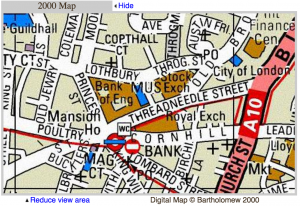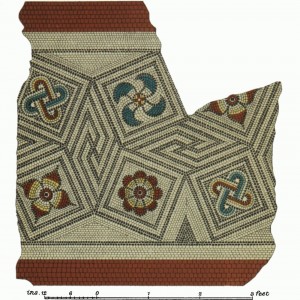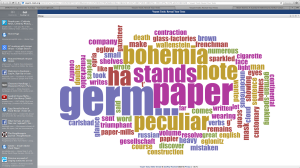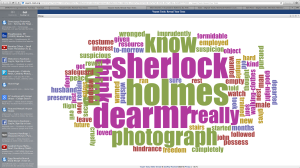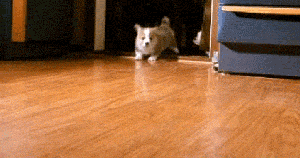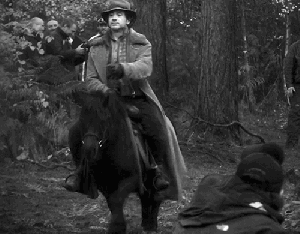By Beth Wynne, Miranda Delancey, Devon Hauser, Jenna Corti, Danielle Koppie, Veronica Verstraten, and Rachel Janowsky.
Sherlock Holmes
Victorian London Locations: Threadneedle Street
Threadneedle Street is mentioned in The Man with the Twisted Lip, where Neville St. Clair, disguised as Hugh Boone, performs his beggary. Boone sits, “Some little distance down Threadneedle Street, upon the left-hand side,” just outside the opium den (Doyle 5). This is where Mrs. St. Clair spots her husband flailing from a window. Before this interruption she walks skeptically, “glancing about in the hope of seeing a cab, as she did not like the neighbourhood in which she found herself” (Doyle 4). The story gives the impression that this was an impoverish and faulty area.
A historical account of Threadneedle St. recalls the area was occupied by “cripples on go-carts who haunted the neighbourhood” (Thornbury, “Threadneedle Street”). This alludes to Doyle’s story quite well considering St. Clair portrayed Boone as a cripple.
Taken from the “Charles Booth Online Archive,” the area surrounding Threadneedle Street was classified as poor. (See Poverty Classification Key.)
It’s hard to see clearly, but the street is located mid photo, above St. Michael. View the “Booth Archive” page, here.
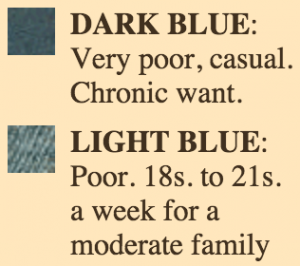
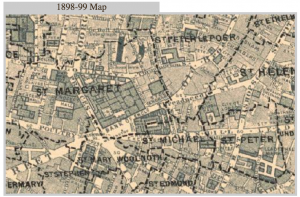 Here’s a better glimpse of Threadneedle Street from 2000.
Here’s a better glimpse of Threadneedle Street from 2000.
The crime and poverty as described in The Twisted Lip and the Poverty Classification (Booth Archive) of Threadneedle St. correspond well.
So, how much crime actually surrounded Threadneedle Street based off of the story in The Twisted Lip? Using “Old Bailey Online,” I was able to find multiple accounts of grand larceny, murder and theft in the Threadneedle St. area. From the Conviction of Henry Harrison, Mr. Harrison, escaped prisoner, hid for sometime in the home of a Mr. Garway. As it is mentioned, “He takes a Lodging at Mr. Garway’s in Threadneedle-street, on the twenty third day of December, and there he continued till about the first of January” (“Henry Harrison, Killing”). Mr. Harrison was a convicted murderer. Pretty profound!
A particular case involved several pieces of stolen clothing by a man named Joseph Johnson, carrying “the Goods of William Savage” from London’s Lombard Street to Threadneedle Street (“Joseph Johnson, Theft”). Other cases involved pickpocketing, and violent encounters. A constable was charged with Edward Lynch, where on “Threadneedle street, [the prisoner] drew a knife upon the prosecutor” and made attempts at the constable as well (“EDWARD LYNCH, Theft”).
Charles Rice, who had stolen innumerable goods, was spotted on Threadneedle Street. Once, by a man named Thomas Edwards who “was coming up Threadneedle-street, when [Rice] was in custody,” and another time by Alexander Barland who saw [Rice] heading towards the “Edinborough coffee-house” (“CHARLES RICE, Theft”).
Edinborough wasn’t the only coffee-house mentioned near Threadneedle St. From “British Histories” I learned of the “North and South American Coffee House (formerly situated in Threadneedle Street)” (Thornbury, “Threadneedle Street”). There was also the Baltic Coffee House, where merchants and brokers occupied their time. It was described as a “rendezvous of tallow, oil, hemp, and seed merchants” (Thornbury, “Threadneedle Street”).
Threadneedle was also the site of the French Protestant Church where red pavement lined the streets. The findings of pavement are rather remarkable and exceptionally crafted (Thornbury, “Threadneedle Street”). It goes to show that Threadneedle St. was not solely defined by theft and poverty but the site of pleasant coffee-houses and decorated pavement.
The Threadneedle Street Pavements:
Works Cited
“Joseph Johnson, Theft, October 1720 (t17201012-3).” Old Bailey Proceedings Online. Web. 6 November 2015. <http://www.oldbaileyonline.org/browse.jsp?id=t17201012-3-defend38&div=t17201012-3#highlight>
“Henry Harrison, Killing, April 1692 (t16920406-1).” Old Bailey Proceedings Online. Web. 7 November 2015. <http://www.oldbaileyonline.org/browse.jsp?id=t16920406-1&div=t16920406-1&terms=+threadneedle%20+street%20#highlight>
“CHARLES RICE, Theft, September 1785 (t17850914-125).” Old Bailey Proceedings Online. Web. 7 November 2015. <http://www.oldbaileyonline.org/browse.jsp?id=t17850914-125&div=t17850914-125&terms=+threadneedle%20+street%20#highlight>
“EDWARD LYNCH, Theft, September 1776 (t17760911-34).” Old Bailey Proceedings Online. Web. 7 November 2015. <http://www.oldbaileyonline.org/browse.jsp?id=t17760911-34&div=t17760911-34&terms=+threadneedle%20+street%20#highlight>
Thornbury, Walter. “Threadneedle Street.” Old and New London: Volume 1. London: Cassell, Petter & Galpin, 1878. 531-544. British History Online. Web. 7 November 2015. <http://www.british-history.ac.uk/old-new-london/vol1/pp531-544>
“Plate 50: Threadneedle Street, Pavements.” An Inventory of the Historical Monuments in London, Volume 3, Roman London. London: His Majesty’s Stationery Office, 1928. 50. British History Online. Web. 5 November 2015. <http://www.british-history.ac.uk/rchme/london/vol3/plate-50>
Holmes and Music
Topic Modeling
Iterations: 1500
Topics: 20
Topics Printed: 20
- ESTATE: house road passed round side place walked carriage garden left master dog horse hall drive path led ground walk standing
- CRIME: man young found inspector house father colonel dead police heard death body attention son crime evidence murder returned dangerous hopkins
- PUBLIC: street found home back station train lord james baker minutes st occurred waiting reached cab hours police late order town
- SEARCH: thought time make give made leave knew great find back hear place things doubt bring chance lost position fellow danger
- EXPRESSION: cried face turned back hands instant hand suddenly head moment voice words sprang forward eyes fell appeared feet lips threw
- APPEARANCE: man eyes face black looked red dark white figure deep hair thin features hat heavy drawn tall appearance blue sharp
- REASONING: clear mind point reason question person find matter idea make means absolutely secret presence impossible save excellent aware explanation sign
- CASE: interest sherlock case facts strange remarkable friend singular account london cases arthur nature problem extraordinary details public effect give find
- SILENT REFLECTION: holmes chair sat gave mrs companion fire fresh visitor rose pipe easy start table glanced silence cold silent horror change
- BUSINESS: business london money men papers set office answered letters brother made hundred work address man considerable great company west mycroft
Topic Modeling
The settings I have used were 100 topics, 5,000 iterations and 30 topic words.
Smoking- chair sat fire pipe rose glanced smoke arm tobacco visitor cigar lit asked laughed silence smoking opposite laid back smoked walk armchair leaning dropped seat comfortable waved cigarette details heartily
Residential Streets- house road side place walked drive miles front led hall high stopped standing building gate windows grounds park trap houses mile yards trees low reached cottage narrow row upper lane
Family/Relationships- woman lady husband wife love young loved beautiful girl marriage daughter married nature women maid fiend de seldom marry blame lovely lover hated mistress loves physical hatred listen merville hilda
Crime (general)- crime murder death night reason police account charge evidence appeared committed proved violence arrest remained motive attempt criminal murdered terrible conduct lucas inquest attention constable probable attempted hideous strong event
Finance- money hundred business pounds thirty thousand large pay milverton worth price fifty sum letters check ten paid firm offer terms named ruin bank work city client advance bag cost market
Transportation- back carriage past drove hurried companion journey round pulled save started reach town reached follow cab drive imagine class early wheels immediately curve van stepped holmes rattled swiftly luggage coachman.
Crime(murder)-back left met father knew death poor sister returned died mother fate witness alive called make swear struck terrible unhappy enemies offered jump faithful reply cry success interview impress absent
Crime Scene- body lay found shot head revolver dead blood weapon wound floor bullet pistol lying handle finally hurt close clothes cried fatal die fired powder wounded brains sight inflicted surgeon horribly
Investigation- case watson effect remarked complete follow conclusion knowledge simple methods form result greatest reasoning work art produced credit observation formed deduction occasionally occur cases working touch step poison drug telegraph
Foreign affairs- english american time von gentleman german bork fancy brother british agents greek london added prisoner occasion england country melas secretary book exclamation living people interpreter car admiration mister worst main
Word Cloud Project: A Scandal in Bohemia
Word clouds or tag clouds are visual depictions of word occurrence that offer greater importance to words that appear more frequently in a piece of text. Moreover, the larger the word is in the cloud, the more common the word was in the source of text.
For the word cloud project, I chose the Voyant word cloud generator and the Sherlock Holmes story called A Scandal in Bohemia. In the first word cloud that I have created, it shows what was happening at the beginning of the story when Sherlock Holmes receives a letter in the mail from the King of Bohemia who is asking Sherlock Holmes to do him a favor. During this part of the story, the words that show up the most often is paper, german, bohemia, stands, note, and peculiar. These key words help the reader to understand how the story obtained the title it was given because the word “peculiar” describes something unusual like a scandal is going on and the word “bohemia” describes the location that is involved in the peculiarity. Moreover, based on this particular word cloud, I learned that something peculiar is happening and somehow an individual from Bohemia is involved based on a note that Sherlock Holmes has received.
In the second word cloud that I developed, it shows what happened at the end of the story when Sherlock Holmes receives a letter from Irene Adler in regards to the most wanted photograph. During this part of the story, it is evident that some of the words that show up most often are Sherlock Holmes, photograph, know, dear, and really. These fundamental words help the reader understand that Sherlock Holmes did in fact find the photograph but failed to realize how stealthy Irene Adler really is.
Even though using word cloud can be an interesting and creative way to portray information, there are also some negative aspects of this tool. According to the Better Evaluation website, one of the pros of this tool is that there are various word and tag cloud generators that are freely available on the internet and creating them is really straightforward. However, based on the Nieman Lab article word clouds can be considered a negative tool because word clouds support only the crudest sorts of textual analysis. In addition, word clouds focus on only the occurrence of specific words instead of concepts and ideas that are important and will help you understand what is going on. Lastly, Word clouds leave the readers to figure out the context of the data by themselves because they have to translate what the jumble of words are trying to depict and explain.
DHM293 Juxta Editions In-Class Lab: Create a Digital Edition of a Holmes Story
Assignment Goal:
For this assignment, you will use Juxta Editions to make a simple digital edition of a Sherlock Holmes story of your choosing. You will use page images either from the first edition of Adventures of Sherlock Holmes or from the original printing in The Strand Magazine. You will upload the page images and make a transcription of the story’s text to create your digital edition. You will then use Juxta Editions’s “Create a Website” option to publish your digital edition.
Due Date: February 27th, 10am (8% of final grade)
Getting Page Images:
- Choose page images from either first edition of Adventures of Sherlock Holmes (https://archive.org/details/adventuresofsher00doyl1) or from the original printing in The Strand Magazine (https://archive.org/details/StrandMagazine9).
- If you choose the version from Adventures of Sherlock Holmes:
- Click the full-screen button (in the shape of a rectangle with 4 small arrows pointing out), then click the button in the shape of an arrow pointing to the right to turn pages in the book. Click it until you find the first page of your Holmes story.
- If you choose the printing from The Strand Magazine:
- use this website (http://www.sshf.com/encyclopedia/index.php/The_Strand_Magazine) to find the publication month of your Holmes story.
- Go back to the Internet Archive The Strand Magazine page, and scroll to below the page images to find a list of the different issues. Click on the correct issue to find your story
- Once on the correct Internet Archive page for your story, scroll down to the list of contents. Find your story and take note of what comes before and after it.
- Scroll back up so you can see the page images. Click the full-screen button (in the shape of a rectangle with 4 small arrows pointing out), then click on the button with an arrow pointing to the right to turn pages in the book. Click it until you find the first page of your Holmes story.
- Right-click on the image of the first page of your story. Select “Save Image as,” rename it “1.jpg,” and save it to the desktop. Click the arrow to reach the next page.
- Repeat step 4 (i.e. Save, rename the image (2.jpg for the second page, and so on), and go to the next page) until you have saved an image file for every page in your story.
- Now, you need to get images for the “Front Matter” and “Back Matter” of your story (e.g. cover page, table of contents, and advertisements). Go to the beginning and end of the book to save and rename the images.
Juxta Editions Set-up:
- Create an account
- Watch instructional videos 1-3 and 5
- Click the blue “Create Edition!” button
- In the new window, under “Name,” put the title of your Holmes story. Under “Description,” write “Digital Edition of” and then the name of your Holmes story. Click “Create.”
- You are now looking at the main page for your digital edition. Click the button labeled “Add Document” to add a document to your edition.
- Under “Document Name,” put the Holmes story’s title, and leave “TEI lite” as the tag schema. Click “Add Document.”
- To start editing your document, click on the title of the story, which should be in blue, under the “Documents in this Edition” section. You’re now ready to add information to your edition.
Adding Metadata to Juxta Editions:
- It’s VITAL to any editions project that you say where your information came from, and this step will show you how.
- Click the words “TEI Header” at the top left side of the page to add information about this digital edition.
- Under the section labeled “Title Statement,” select “Main Title,” and make sure the title of your Holmes story is in the text field across from it.
- Under “Author,” write “Sir Arthur Conan Doyle.”
- Under “Editor,” write your name.
- Click the next tab, labeled “Publication Statement” (publication information about this digital edition.)
- Under “Name,” put “Digital Tools for the 21st Century”
- Under “Place,” write “New Paltz”
- Under “Date,” put today’s date
- Click the next tab, labeled “Source Description,” and click the button labeled “Structured” to give you some more boxes to fill out about the original story.
- Title: your story name
- Author: Sir Arthur Conan Doyle
- Name: either The Strand Magazine or “A.L. Burt Company” (for Adventures)
- Place: either London (Strand) or “New York” (Adventures)
- Click the “Save” button in the lower right-hand corner
Uploading Front and Back Matter into Juxta Editions (cover, title page, table of contents):
- Click on the icon of 4 lines with dots in front of them (next to the button labeled “Side by Side” at the bottom left of the screen), and select “Front Matter.”
- Click the button labeled “Upload Image.”
- In the next window, select the first image for the front matter and click “Open”
- In the right-hand window, directly opposite the image, transcribe the text from the image.
- To add a second page of front matter, click the button labeled “New Page” in the upper left immediately below the words “TEI Header.”
- Repeat steps 2-5 until you’ve added all the front matter. Then click “Save” (Upper right hand button)
- Repeat steps 1-6, but select “Back Matter.”
Uploading and Transcribing Page Images of the Story:
- In the pop-up window on the left (where you selected “Front Matter”), select “Document Body.”
- Click on the button labeled “Transcription” (below the button labeled “New Page,” and select “General Use.”
- Click “Upload Image” and choose the first image of the story’s text.
- In another tab of your browser, navigate https://sherlock-holm.es/ascii/ (plain text for all Holmes stories)
- In this website, find the title of your story and click the link.
- Find only the text that appears on the page you’ve uploaded into your digital edition, and copy it.
- Paste it into the empty box on the right-hand side of the Juxta Editions screen.
- Use the “Names, Dates, and Places” tagset to tag every name, date, and place in each page. Use the “General Use” tagset to bold and italicize anything that needs it in each page.
- Repeat step 3, 6 and 7 for every page of the story. Make sure to save frequently.
- Once every page image has been uploaded and every page has been transcribed, proofread the transcription and correct errors.
Getting Credit for Website:
- Click the button labeled “Preview” (between “New Page” and “Export as XML”) to see what your edition will look like in its final version.
- If you don’t see anything to change, then you’re ready to submit it.
- Email me your username and password so I can access your website.
Extra Credit: Victorian London Dictionary – “Ladies Shopping”
While browsing through the Victorian London Dictionary trying to look for an article that would intrigue and catch my interest, I finally found the one! SHOPPING – Something that I know how to do best….
While perusing through the article called “Ladies Shopping” I came across a quite accurate definition of shopping, if I do say so myself. As defined by The London Victorian Dictionary, “Shopping is the amusement of spending money at shops.” Women love shopping as much as men love to play sports. Unlike shopping, sport involves the payment of one’s own shot, however shopping may be maintained by getting it paid for.
During Victorian London, the best places for shopping were fashionable streets and bazaars. Street-shopping essentially is directed toward hosiery, drapery, and jewelry of the richer sort. Bazaar and Arcade-shopping, to fancy articles, nick nacks, and perfumery. I learned that women had to act differently depending on the type of shopping they are doing. “In street-shopping walk leisurely along, keeping a sharp look-out on the windows. In bazaar-shopping, beat each stall separately.” They also advised women to finish street-shopping before she takes on the bazaars and arcades because the last two refer to mostly articles of no manner of use.
I chose this article because I really enjoy going shopping and I found it fascinating how the diversion and entertainment of shopping has evolved over the years.
Introduction
Hi there! My name is Christine Wohltjen. I’m currently a senior at SUNY New Paltz, and I’m studying Digital Media Production.
Some of my personal interests are below:
And for a video that’s sure to make your day a little better, click here
Starter post
Hi! The name is Lauren Gao, pronounced like “go”. A senior who is a double major in Interpersonal Communication and Linguistics. I actually have another in-the-works blog on this wordpress account to document my year abroad in Hong Kong. Emphasis on the phrase “in-the-works”.
Hopefully DHM293 might help me change that!
Have a barely related Sherlock Holmes picture (gif).
Thanks for reading!
